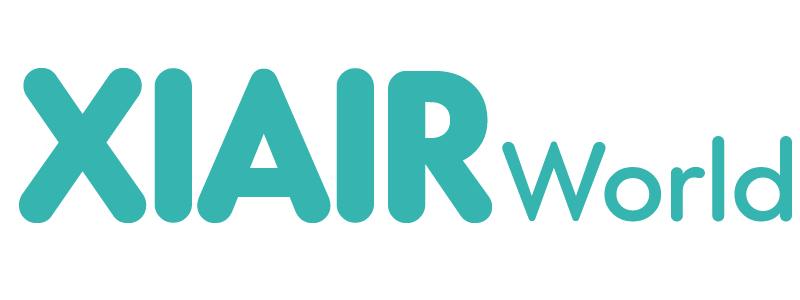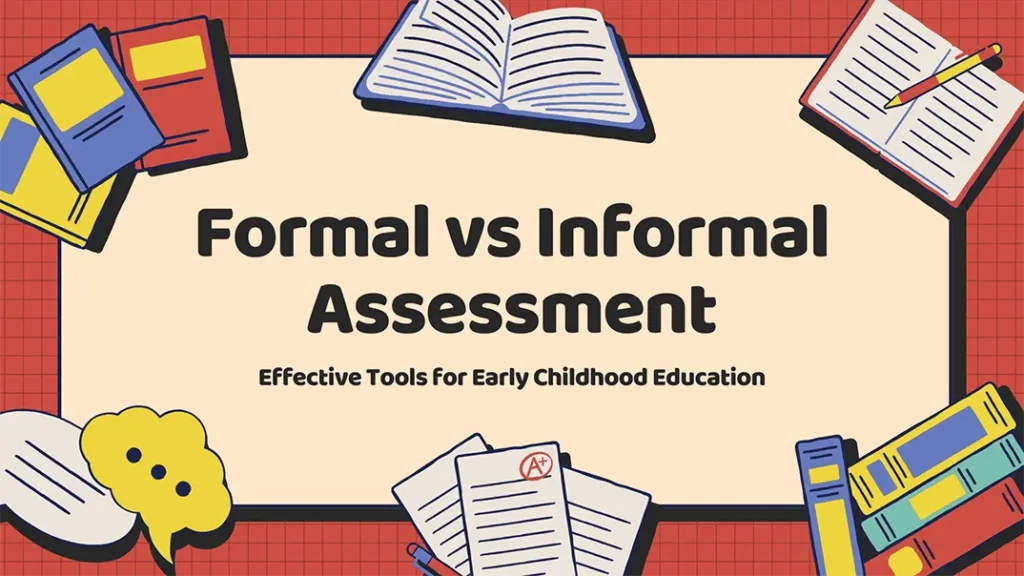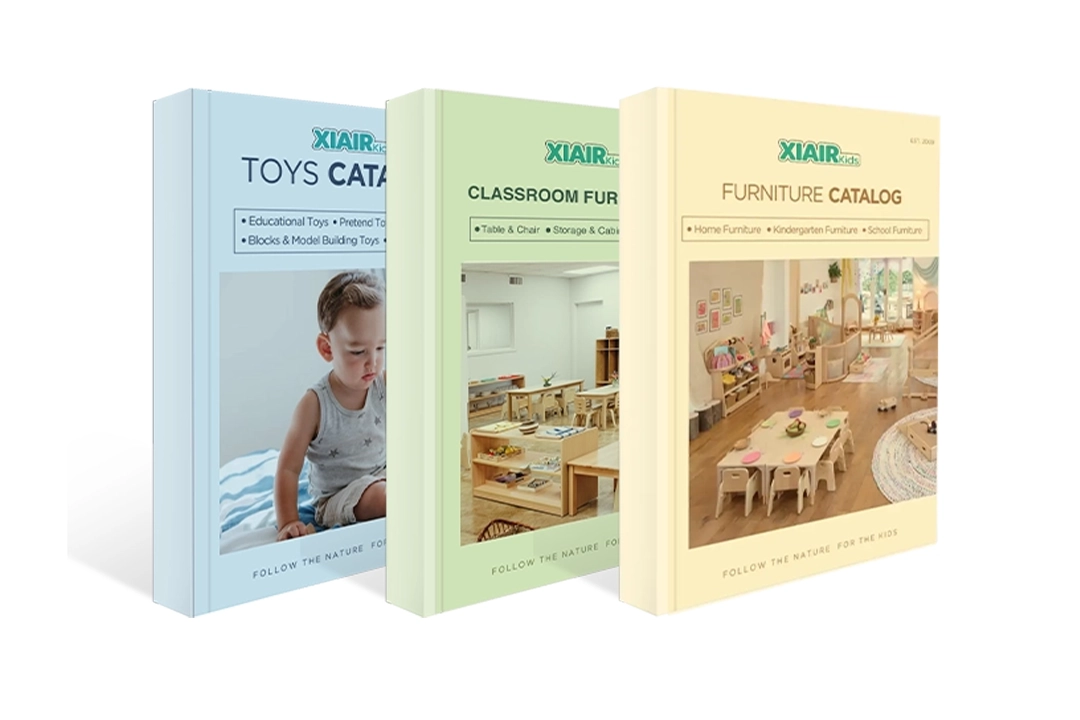Formal vs informal assessment has become a common debate among educators and administrators. Are standardized tests capable of capturing a child’s developmental progress, or do informal tools offer a more authentic glimpse into learning? When each child is unique and learns at their own pace, how do we ensure our evaluations are both fair and meaningful?
Understanding the nuances of formal vs informal Assessment can empower educators to make informed, child-centered decisions. Formal assessments offer measurable, structured data often required for institutional reporting. Informal assessments, on the other hand, provide rich, contextual insights through real-time observations, interactions, and documentation.
In the following sections, we’ll examine formal vs informal assessment in more detail, compare their differences, reveal their respective pros and cons, and help you choose the right one for your child.
Assessment in Early Childhood Education
Assessment in early childhood education refers to the ongoing process of gathering, interpreting, and using information about a child’s development and learning. It is not simply a way to measure academic achievement; it’s a multifaceted tool that provides educators, families, and specialists with valuable insights into a child’s strengths, needs, and growth over time.

At its core, assessment serves as the foundation for intentional teaching. In the early years, when children rapidly develop cognitive, social, emotional, and physical skills, understanding their progress is vital. Through assessment, educators can tailor their instruction, set appropriate learning goals, and ensure that every child is supported in their unique developmental journey.
In early childhood education, assessment is not a one-time event. It’s a continuous, dynamic part of the daily learning process. Teachers use it to observe how children interact with their environment, peers, and learning materials. Whether through structured tests or spontaneous observations, assessment helps educators recognize emerging skills, identify challenges, and celebrate milestones.
Moreover, assessment plays a critical role in communication. It bridges the gap between educators and families by providing concrete evidence of a child’s development. It also informs collaboration with specialists when early intervention is needed. As such, it doesn’t just support learning—it enhances relationships and trust among all stakeholders involved in a child’s early education.
What Is Formal Assessment?
Formal assessment in early childhood education refers to structured, standardized tools to evaluate a child’s performance against predetermined benchmarks or learning standards. These assessments are typically designed with consistency in administration and scoring, aiming to produce objective, comparable results across different individuals or groups.

The primary purpose of formal assessment is to measure specific knowledge or skills through quantifiable methods, often in areas like literacy, numeracy, and cognitive development. These assessments are usually scored externally or using uniform rubrics, and they frequently contribute to data used in school readiness evaluations, funding decisions, or educational planning.
Characteristics of Formal Assessment
- Standardized Procedures: Administered in the same way for all students to ensure consistency and fairness.
- Quantitative Scoring: Results are typically numerical or categorical (e.g., percentiles, scores, proficiency levels).
- Pre-planned and Scheduled: Conducted at specific times during the school year, not embedded in daily instruction.
- Objective Measurement: Designed to reduce subjectivity by using predetermined criteria or external evaluators.
- Data-Driven Outcomes: Often used to inform policy, curriculum development, or individualized learning plans.
Examples of Formal Assessment
- Performance-Based Tasks (when formally structured)
These may include guided activities like presenting a learned concept or completing a teacher-scored task using a rubric. When scored objectively, these are considered formal. - Standardized Tests
Used in preschool or kindergarten to assess skills like early literacy, numeracy, or language development. These tests follow a consistent format and scoring system (e.g., DIBELS, PPVT). - End-of-Term Exams
Comprehensive assessments are conducted at the end of a semester or school year to evaluate cumulative learning in key subjects like math and reading. - Quizzes and Unit Tests
Structured tests are designed to measure understanding of specific topics taught during a short instructional period, such as letter sounds or number recognition. - Criterion-Referenced Tests
Assessments that measure a child’s performance against defined learning standards, such as kindergarten readiness benchmarks. - Aptitude Tests
Used to evaluate a child’s potential in areas like verbal reasoning, memory, or problem-solving skills (e.g., WPPSI, KBIT).
Advantages and Limitations of Formal Assessment
Formal assessment plays a significant role in early childhood education, offering educators structured insight into children’s learning progress. However, like any tool, it comes with both strengths and challenges. Understanding these helps educators use formal assessments more effectively and make informed decisions about when and how to apply them.

Advantages of Formal Assessment
- Objective and Consistent
Formal assessments are administered and scored uniformly, reducing bias. This consistency allows educators and administrators to compare results across groups, schools, or regions. - Data-Driven Decision Making
The quantitative nature of formal assessments provides measurable outcomes, which help track progress, identify trends, and inform curriculum adjustments. - Early Identification of Learning Needs
Standardized tools can help flag developmental delays or learning difficulties early on, allowing for timely intervention and support. - Accountability and Reporting
Results from formal assessments support accountability at institutional levels. They are often required for educational funding, compliance, or school readiness evaluations. - Alignment with Standards
These assessments are usually designed to align with state or national learning objectives, helping ensure children are meeting key developmental benchmarks.
Limitations of Formal Assessment
- Limited Scope
Formal assessments often focus on academic or cognitive skills, overlooking social, emotional, or creative aspects of development that are equally important in early childhood. - Lack of Context
They typically evaluate performance in isolated settings, which may not reflect a child’s actual abilities or day-to-day learning behavior. - Stress and Pressure
Structured testing environments can be stressful or unfamiliar for young children, potentially affecting performance and undermining their confidence. - Cultural and Linguistic Bias
Standardized tests may not account for the diverse backgrounds of children, resulting in inaccurate assessments for those from non-dominant language or cultural groups. - Reduced Flexibility
Unlike informal assessment, formal methods often lack adaptability to individual learning styles or real-time classroom dynamics.
What Is Informal Assessment?
Informal assessment refers to educators’ flexible, day-to-day strategies for observing and understanding a child’s learning and development in natural settings. Unlike formal assessments, which rely on structured tools and standardized scoring, informal assessments are embedded into everyday classroom activities and interactions. They are often qualitative, relying on the teacher’s observations, notes, and professional judgment.
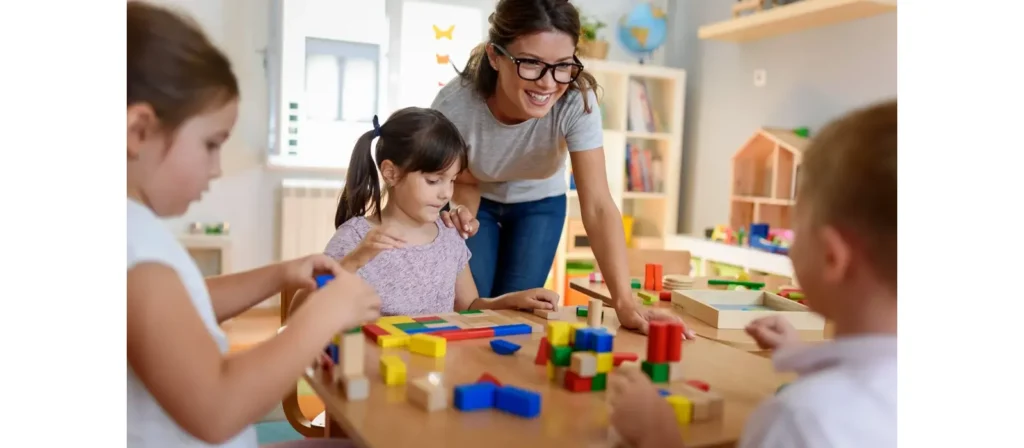
In early childhood education, informal assessment plays a vital role in capturing the nuances of how children think, communicate, explore, and grow. It allows educators to assess skills in real time and in context, whether during free play, group activities, storytelling, or hands-on learning. These insights help teachers adjust instruction, personalize learning, and support children’s individual needs without interrupting the natural flow of the classroom.
Characteristics of Informal Assessment
- Flexible and Ongoing: Conducted continuously throughout the day during regular activities, without a fixed schedule or format.
- Contextual and Naturalistic: It takes place in real-world settings, such as during play, conversation, or group tasks, and it reflects how children actually learn and behave.
- Qualitative and Descriptive: Relies on notes, checklists, photographs, or videos that capture detailed information about a child’s behavior, language, or social skills.
- Teacher-Guided: Based on the educator’s insights, professional judgment, and knowledge of child development, rather than standardized scoring.
- Child-Centered: Sensitive to each child’s pace, background, interests, and learning style, making it highly inclusive and responsive.
Examples of Informal Assessment
- Anecdotal Records
Brief, descriptive notes taken by educators during classroom activities to document a child’s behavior, language, or social interactions in real time. - Observations During Play
Teachers observe children’s interactions with peers, use materials, and solve problems during free play to assess their developmental skills and learning styles. - Learning Portfolios
Collections of a child’s work, such as drawings, writing samples, and photos, showcase growth in various domains over time. - Checklists and Rating Scales (when teacher-designed and used informally)
Used by educators to track the presence or frequency of certain behaviors or skills during everyday routines. - Teacher-Child Conversations
Informal discussions, storytelling, or questioning are used to gauge comprehension, language use, and critical thinking in a relaxed setting. - Journal or Drawing Reflections
Children express their thoughts or understanding through pictures or simple journaling, providing insights into their ideas and emotions.
Advantages and Limitations of Informal Assessment
Informal assessment is a powerful and flexible tool in early childhood education. It allows educators to observe and evaluate children in natural settings, capturing the richness of everyday learning. However, while informal assessment offers deep insights, it also has limitations that must be acknowledged to ensure effectiveness.
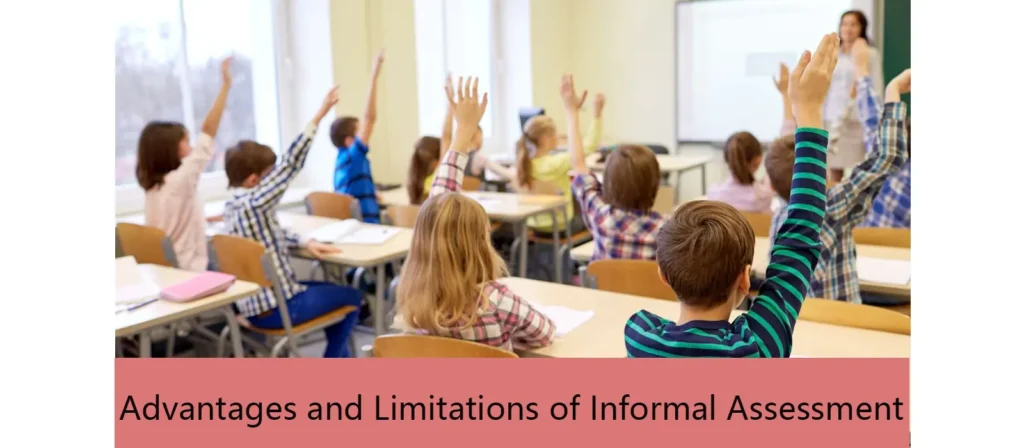
Advantages of Informal Assessment
- Real-World Relevance
Informal assessment occurs in authentic settings, such as playtime, group work, or routines. This allows educators to see how children apply skills in meaningful contexts. - Holistic View of the Child
It captures not only academic development but also emotional, social, and behavioral growth, offering a more complete understanding of the child. - Responsive and Flexible
Informal methods can be instantly adapted to a child’s needs, interests, or behavior, making them ideal for differentiated instruction. - Less Stressful for Children
Since it’s embedded in daily activities, informal assessment feels natural and non-intimidating, especially for young learners who may not respond well to formal testing. - Strengthens Teacher-Child Relationships
Continuous, informal observation builds deeper connections, as educators engage more directly and personally with each child’s learning journey.
Limitations of Informal Assessment
- Subjectivity
Because it relies on teacher observations and interpretations, results may vary depending on the educator’s experience, bias, or expectations. - Lack of Standardization
Informal assessments are often not comparable across classrooms or schools, making it harder to track progress on a larger scale. - Documentation Challenges
Gathering and organizing informal data, such as notes, photos, or portfolios, can be time-consuming and inconsistent if not managed carefully. - May Overlook Gaps in Learning
Because informal assessment is often unstructured and observational, educators might unintentionally overlook subtle learning difficulties or gaps in skill development, especially in quiet or less expressive children. - Limited Use in Reporting and Policy
Informal assessments are less likely to be accepted for formal documentation, funding applications, or standardized reporting requirements.
Не просто мечтайте, а проектируйте! Давайте обсудим ваши индивидуальные потребности в мебели!
Why It’s Important to Understand the Difference Between Formal vs Informal Assessments?
Misunderstanding the difference between formal vs informal assessments can lead to inappropriate evaluation methods, misjudged developmental progress, or missed learning needs. For example, relying solely on formal tests may overlook a child’s social or emotional growth, while depending only on informal observations may fail to identify specific academic gaps. Each type of assessment collects different kinds of data, and without clarity, educators may draw incomplete or inaccurate conclusions about a child’s abilities.
Recognizing both assessment types’ unique purpose and value enables educators to make more intentional, balanced decisions. It helps them choose the right tool for the right situation—whether diagnosing a learning delay, planning instruction, or documenting progress for parents or administrators. This clarity improves teaching effectiveness, fosters better communication with families, supports individualized learning plans, and builds a more responsive, inclusive early learning environment.
Differences Between Formal vs Informal Assessment
Understanding the contrast between formal and informal assessments requires examining several core dimensions. Below are the major areas where these two types of assessment differ, helping educators select the most appropriate approach for their goals.
Purpose: Formal vs Informal Assessment
Formal Assessment:
The primary goal of formal assessment is to measure how well a child meets predefined academic or developmental standards. These assessments are often tied to curriculum goals, state benchmarks, or institutional accountability. They are commonly used for school readiness decisions, identifying learning delays, or providing data for policy or funding purposes. The focus is on generating measurable, comparative data across students or groups.
Informal Assessment:
Informal assessments aim to understand a child’s development in a more holistic and personalized way. They provide daily instruction, recognize developmental patterns, and support the child’s individual learning journey. Rather than focusing on comparison or compliance, informal assessments help educators understand each child’s needs, strengths, and interests as they unfold in natural settings.
Types: Formal vs Informal Assessment
Formal Assessment
Formal assessment encompasses a narrow but structured set of tools designed to measure specific academic or developmental outcomes. These tools follow standardized procedures and scoring systems, ensuring consistency and comparability across students and settings. They are often used to assess readiness, diagnose delays, or report achievement levels.
Common Types of Formal Assessment:
- Standardized achievement tests (e.g., literacy or math readiness tests)
- End-of-term or summative exams
- School readiness or entrance exams
- Diagnostic tools for developmental screening
- Performance-based assessments with fixed rubrics
- Criterion-referenced assessments aligned with standards
Informal Assessment
Informal assessment includes a much broader and more flexible array of strategies that occur naturally in everyday learning environments. These assessments are typically observational, descriptive, and contextual, allowing educators to capture how children learn, behave, and interact in real time.
Common Types of Informal Assessment:
- Reflective journals or visual storytelling
- Anecdotal records or teacher observations
- Learning portfolios (collections of drawings, writing, projects)
- Teacher-created checklists or rating scales
- Child-led conferences or presentations
- Peer interactions and group discussions
- Spontaneous teacher-child conversations or questioning

Scope: Formal vs Informal Assessment
Formal Assessment
Typically focuses on specific academic or cognitive areas, such as literacy, numeracy, or language development. While some formal tools may assess physical or emotional development, the scope is often narrower and tied to performance-based outcomes.
Informal Assessment
Offers a broader scope that encompasses not just academic skills, but also emotional, social, behavioral, and physical development. It allows educators to capture a more holistic view of the child’s growth and learning across all areas of development.
Structure and Format: Formal vs Informal Assessment
Formal Assessment
Formal assessments follow strict guidelines regarding structure, format, and administration. They include standardized tests, performance-based tasks with rubrics, and multiple-choice or fill-in-the-blank exams. To ensure fairness and reliability, all students receive the same instructions, questions, and timing.
Informal Assessment
Informal assessments are unstructured or loosely structured, allowing educators to observe and record children’s learning as it naturally occurs. Formats include observational notes, student conversations, work samples, or spontaneous teacher-child interactions. There are no uniform procedures, making them highly adaptable to the classroom environment.
Timing: Formal vs Informal Assessment
Formal Assessment
These assessments are administered at planned intervals, such as the beginning, middle, or end of a school term. They are often scheduled as part of a curriculum or mandated by the school or district. The timing is fixed and rarely adjusted to suit individual children.
Informal Assessment
Informal assessments are conducted continuously throughout the day and in regular classroom activities. A teacher might assess a child’s language development during circle time or observe problem-solving skills during play. No set timeline makes the process responsive to each child’s moment-to-moment behavior.
Data Type: Formal vs Informal Assessment
Formal Assessment
The data collected from formal assessments is typically quantitative. It results in numerical scores, grade levels, percentiles, or other standardized outcomes that can be tracked over time or compared across populations. This kind of data is often used for statistical analysis and school-wide reporting.
Informal Assessment
Informal assessments yield qualitative data that focuses on descriptive, contextual insights. This includes narrative notes, anecdotal records, developmental checklists, or learning portfolios. While not easily converted into statistics, this data offers depth and meaning that numbers alone can’t provide.
Setting: Formal vs Informal Assessment

Formal Assessment
These assessments are conducted in controlled, often quiet environments designed to minimize distractions. Children are expected to work independently under supervision, often away from the typical classroom flow, to maintain standardization and reliability.
Informal Assessment
Informal assessments happen in familiar, natural settings—during play, mealtime, group activities, or outdoor exploration. This approach helps children feel more comfortable and allows educators to observe genuine behavior and skills as they emerge organically.
Scoring and Evaluation: Formal vs Informal Assessment
Formal Assessment
Scoring is objective and based on predefined criteria or answer keys. Educators or external scorers follow clear rubrics to evaluate performance, reducing subjectivity. The results are often converted into scores or levels used for comparison or reporting.
Informal Assessment
Evaluation is more interpretive and based on the teacher’s observations, experience, and understanding of each child’s developmental stage. While some tools like checklists may provide structure, the scoring is often narrative, descriptive, or illustrative rather than numeric.
Flexibility and Adaptability: Formal vs Informal Assessment
Formal Assessment
Formal tools have limited flexibility and are designed for uniform application. Modifying them can compromise validity, making them less suitable for children with unique learning styles, language differences, or developmental delays.
Informal Assessment
Highly adaptable informal assessments allow educators to shift strategies based on the child’s mood, interests, or background. Teachers can adjust the setting, format, or timing to support the individual child better, making this approach more inclusive and responsive.
Child’s Experience: Formal vs Informal Assessment

Formal Assessment
Formal assessments may feel unfamiliar, rigid, or intimidating for young children. The pressure to perform in a structured setting can cause anxiety or disengagement, especially if the tasks do not align with their developmental readiness.
Informal Assessment
Children often don’t even realize they are being assessed during informal methods. Because these assessments are woven into enjoyable, low-pressure activities, they feel more relaxed and authentic, giving educators a more accurate view of the child’s true capabilities.
Use in Reporting: Formal vs Informal Assessment
Formal Assessment
Results from formal assessments are commonly used in official documentation, school records, and reporting to families or education authorities. These assessments are required for compliance, accountability, and decision-making at the institutional level.
Informal Assessment
Informal results are recorded in portfolios, observation logs, or shared verbally during parent-teacher conferences. While not always part of official records, they provide meaningful, individualized evidence of growth over time and enrich the formal picture.
When to Use: Formal vs Informal Assessment
Formal Assessment
Formal assessments are most appropriate when standardized, measurable data is needed to evaluate school readiness, diagnose developmental delays, or report academic achievement to external stakeholders. These assessments are typically used at set points in the academic year and are aligned with institutional goals, making them essential for accountability, policy decisions, or eligibility for special programs.
Informal Assessment
Informal assessments are best used for daily instructional decision-making, observing real-time development, and gaining a holistic understanding of a child’s learning behaviors. They are ideal for ongoing monitoring, responding to individual learning styles, and adjusting teaching strategies in the moment. Informal methods also enhance parent communication by offering narrative-rich, contextual examples of growth.
Не просто мечтайте, а проектируйте! Давайте обсудим ваши индивидуальные потребности в мебели!
Similarities Between Informal vs Formal Assessment
While informal and formal assessments differ in structure and execution, they share several important commonalities. Recognizing these similarities helps educators integrate both methods into a cohesive and effective assessment strategy.

Focus on Child Development
At their core, both assessment types aim to support and understand children’s developmental progress. They help educators gain insights into cognitive, social, emotional, and physical growth, ensuring each child receives the support needed for holistic development.
Guide Instructional Decisions
Both assessments inform teaching practices through structured test results or observational notes. They provide educators with evidence to adjust lesson plans, differentiate instruction, and address the diverse learning styles and needs present in the classroom.
Monitor Progress Over Time
Formal and informal assessments contribute to tracking how children evolve. They help identify learning patterns, assess growth, and determine whether children meet developmental milestones or educational objectives.
Identify Learning Needs
Both assessment forms help pinpoint children who may need additional support, whether academically, socially, or behaviorally. Early identification allows for timely interventions that can significantly improve outcomes for young learners.
Enhance Communication with Families
Assessment findings—whether in test scores or narrative portfolios—are critical tools for engaging families. They provide a structured way to share a child’s progress, encourage collaboration, and align home and school efforts in supporting learning.
How to Use Formal and Informal Assessments?
Effectively integrating formal assessment vs informal assessment in the early childhood classroom allows educators to view each child’s development comprehensively. These methods offer a balanced approach to planning instruction, supporting individual needs, and communicating progress.

Using Formal Assessments in the Classroom
Formal assessments should be thoughtfully planned and implemented at specific intervals to evaluate developmental benchmarks, academic skills, or readiness indicators. These tools provide essential data for long-term planning and accountability.
Tips for using formal assessments:
- Schedule purposefully: Administer at key points in the year, such as entry, mid-year, and exit, to evaluate progress and readiness.
- Align with curriculum goals: Choose assessments that directly relate to your learning standards or program objectives.
- Create a supportive environment: Prepare children with practice activities, explain expectations clearly, and reduce stress through positive reinforcement.
- Interpret results in context: Use assessment data alongside classroom knowledge to avoid making assumptions based solely on scores.
- Document and communicate: Keep organized records and share results with families in clear, accessible language, explaining what the data means for their child’s development.
Using Informal Assessments in the Classroom
Informal assessments are most powerful when they are seamlessly integrated into daily routines, play, and interactions. These assessments help educators understand what children know and how they learn, communicate, and adapt.
Tips for using informal assessments:
- Be a purposeful observer: Watch how children approach tasks, solve problems, interact with peers, and express emotions during various classroom activities.
- Capture evidence creatively: Use notes, checklists, recordings, or photos to document learning in action without interrupting it.
- Foster reflection: Encourage children to talk about their work, make choices, and set simple goals, reinforcing ownership of learning.
- Use portfolios meaningfully: Compile work samples over time to visualize growth and identify learning patterns across developmental areas.
- Respond in the moment: Adjust your teaching immediately based on what you observe, offering support, challenge, or new directions as needed.
Combining Formal and Informal Assessments
Using formal and informal assessments in tandem provides the most complete picture of a child’s learning journey. While formal tools offer measurable benchmarks, informal methods supply real-time, contextual insights that numbers alone can’t capture.
Strategies for integration:
- Cross-reference data: Use informal observations to validate or explain formal test results, identifying gaps or confirming strengths.
- Plan instruction holistically: Base your lesson planning on patterns seen in both types of assessments to meet academic and developmental goals.
- Use informal assessment to prepare for formal testing: Observations can guide readiness and highlight areas needing attention before a standardized test.
- Balance reporting: When communicating with families or administrators, present both numeric data and descriptive narratives for a fuller, more meaningful report.
- Reflect as a team: Collaborate with colleagues to combine insights from both methods, enhancing program-wide understanding and support strategies.
How to Interpret and Use Assessment Data?
Once assessments are conducted, the real value lies in how the data is interpreted and applied. Formal and informal assessment data offer valuable insights but require different analysis, communication, and instructional planning approaches.

Working with Formal Assessment Data
Formal assessment data is typically numerical, standardized, and aligned with specific benchmarks. Interpreting this type of data involves understanding scores within the context of age-level expectations and broader developmental standards.
Key strategies:
- Review results in context: Look beyond the score. Consider the child’s mood, familiarity with the format, language ability, and cultural background.
- Identify trends and gaps: Analyze data across subjects or time periods to detect patterns, such as consistent strengths or areas of concern.
- Compared to benchmarks: Use established cutoffs or standards to determine readiness, mastery, or need for support in specific skill areas.
- Share data appropriately: When discussing with families, translate technical language into plain terms, and explain what the scores imply for learning.
- Use data to plan support: Group children by skill level, provide targeted interventions, or adjust curriculum pacing based on overall class results.
Working with Informal Assessment Data
Informal assessment data is qualitative and descriptive, often consisting of notes, samples, photos, or child dialogue. It provides a rich narrative of the child’s learning process and must be organized thoughtfully to support decision-making.
Key strategies:
- Organize and store consistently: Use portfolios, observation logs, or digital documentation tools to keep records accessible and track growth over time.
- Look for developmental patterns: Review multiple observations or work samples to identify emerging skills, interests, or behavioral trends.
- Reflect and analyze: Take time to review informal data regularly. What does the child consistently show or struggle with? Are there changes over time?
- Use in planning: Use children’s observed interests, strengths, and needs to inform lesson design and activity choices.
- Communicate clearly: Share examples and narratives with families to help them visualize their child’s learning beyond test scores.
Ваш идеальный класс всего в одном клике от вас!
Misconceptions About Formal and Informal Assessments
Misconceptions about formal and informal assessments can lead to ineffective practices, misinterpret results, or missed opportunities for child development. Recognizing and correcting these misconceptions can ensure that both types of assessments function as powerful, complementary tools in early childhood education.
1. Only Formal Assessments Provide Valid Results
Many assume that formal assessments are the only legitimate way to evaluate learning because they produce scores and follow standardized procedures. This belief often stems from pressure to show measurable outcomes and meet institutional expectations.
Informal assessments offer equally important insights by capturing how children think, behave, and learn in natural contexts. Educators should treat both types as complementary, using formal assessments for structured measurement and informal ones for daily developmental understanding.
2. Informal Assessments Are Unstructured and Unreliable

There’s a perception that informal assessments lack rigor because they don’t involve fixed questions or scoring systems. As a result, they’re sometimes seen as too casual to be meaningful.
However, informal assessments are most effective when planned with intention and recorded consistently. By using tools like checklists, observation forms, and portfolios, educators can ensure informal data is just as reliable and informative as formal metrics.
3. Children Should Show the Same Performance on Both Assessment Types
Some educators expect that a child who performs well in informal observations should do equally well in formal tests—and vice versa. When this doesn’t happen, one set of results may be unfairly questioned.
Performance often varies based on the child’s comfort, environment, or familiarity with the format. It’s important to view inconsistencies as opportunities to explore deeper, rather than as contradictions. Using both assessments together provides a more accurate picture.
4. Formal Assessments Are Too Stressful for Young Children and Should Be Avoided
Educators may avoid formal assessments entirely out of concern that they create anxiety or are inappropriate for young learners. This results in lost opportunities to gather valuable developmental data.
The solution is to choose age-appropriate, low-pressure tools and introduce them through play-like activities. Formal assessments can be stress-free and informative when presented in a familiar and supportive environment.
5. Informal Assessments Don’t Need to Be Documented
Because informal assessments happen during play or routine activities, they’re often assumed to be too informal to require written records. This can lead to lost observations and limited continuity.
Educators should document key insights using simple tools, such as photos, learning stories, or short notes, to make informal assessments meaningful. Regular documentation supports planning, reflection, and communication with families.
Frequently Asked Questions: Formal vs Informal Assessment
- What is the main difference between formal and informal assessment?
Formal assessment is structured and standardized and produces measurable results (e.g., tests and exams), while informal assessment is observational, flexible, and occurs naturally in the среда обучения. - Can both formal and informal assessments be used together?
Yes, using both provides a complete understanding of a child’s development. Formal tools give objective data, while informal assessments offer rich, contextual insights. - Which type of assessment is better for young children?
Neither is “better”—each serves different purposes. Informal assessments are ideal for daily instruction and capturing natural behaviors, while formal assessments help track progress and identify developmental needs. - Are informal assessments considered valid in educational settings?
Absolutely. When used systematically and appropriately documented, informal assessments are highly valuable and widely accepted for planning, evaluation, and family communication. - How often should formal assessments be conducted in early childhood?
Formal assessments are typically conducted at key intervals, such as the beginning or end of the year. The frequency depends on program goals, reporting requirements, and child needs. - Can informal assessments help identify learning difficulties?
Yes, informal assessments often reveal early signs of challenges through patterns in behavior, participation, or skill development, leading to timely support or referrals. - How should assessment results be shared with families?
Use a combination of quantitative data (from formal assessments) and qualitative examples (from informal assessments) to give a well-rounded picture of a child’s growth, strengths, and focus areas.
Заключение
Understanding the strengths and roles of formal and informal assessment is essential for delivering meaningful, responsive early childhood education. Rather than viewing them as opposing approaches, educators should recognize that both serve valuable—and often complementary—functions in the classroom.
By using the correct type of assessment at the right time—and interpreting the results thoughtfully—educators can make informed decisions that genuinely support every child’s growth. Balancing structure with flexibility, and data with observation, leads to more inclusive, effective, and developmentally appropriate learning experiences.
